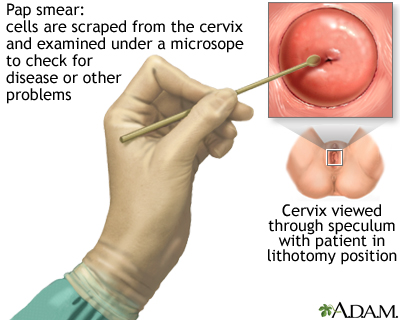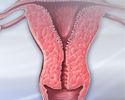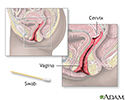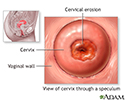Pap test
Papanicolaou test; Pap smear; Cervical cancer screening - Pap test; Cervical intraepithelial neoplasia - Pap; CIN - Pap; Precancerous changes of the cervix - Pap; Cervical cancer - Pap; Squamous intraepithelial lesion - Pap; LSIL - Pap; HSIL - Pap; Low-grade Pap; High-grade Pap; Carcinoma in situ - Pap; CIS - Pap; ASCUS - Pap; Atypical glandular cells - Pap; AGUS - Pap; Atypical squamous cells - Pap; HPV - Pap; Human papilloma virus - Pap cervix - Pap; Colposcopy - Pap
The Pap test checks for cervical cancer. Cells scraped from the opening of the cervix are examined under a microscope. The cervix is the lower part of the uterus (womb) that opens at the top of the vagina.
This test is sometimes called a Pap smear.
How the Test is Performed
You lie on a table and place your feet in stirrups. The health care provider gently places an instrument called a speculum into the vagina to open it slightly. This allows the provider to see inside the vagina and cervix.
Vagina
The vagina is the female body part that connects the womb (uterus) and cervix to the outside of the body.

Cells are gently scraped from the cervix area. The sample of cells is sent to a lab for examination.
How to Prepare for the Test
Tell your provider about all the medicines you are taking. Some birth control pills that contain estrogen or progestin may affect test results.
Also tell your provider if you:
- Have had an abnormal Pap test
- Might be pregnant
DO NOT do the following for 24 hours before the test:
- Douche (douching should never be done)
- Have intercourse
- Use tampons
Avoid scheduling your Pap test while you have your period (are menstruating). Blood may make the Pap test results less accurate. If you are having unexpected bleeding, do not cancel your exam. Your provider will determine if the Pap test can still be done.
Empty your bladder just before the test.
How the Test will Feel
A Pap test causes little to no discomfort for most women. It can cause some discomfort, similar to menstrual cramps. You may also feel some pressure during the exam.
You may bleed a little bit after the test.
Why the Test is Performed
The Pap test is a screening test for cervical cancer. Most cervical cancers can be detected early if a woman has routine Pap tests.
Screening should start at age 21.
After the first test:
- You should have a Pap test every 3 years to check for cervical cancer.
- If you are over age 30 and you also have HPV testing done, and both the Pap test and HPV test are normal, you can be tested every 5 years (HPV is the human papillomavirus, the virus that causes genital warts and cervical cancer).
- Most women can stop having Pap tests after age 65 to 70 as long as they have had 3 negative tests within the past 10 years.
You may not need to have a Pap test if you have had a total hysterectomy (uterus and cervix removed) and have not had an abnormal Pap test, cervical cancer, or other pelvic cancer. Discuss this with your provider.
Normal Results
A normal result means there are no abnormal cells present. The Pap test is not 100% accurate. Cervical cancer may be missed in a small number of cases. Most of the time, cervical cancer develops very slowly, and follow-up Pap tests should find any changes in time for treatment.
What Abnormal Results Mean
Abnormal results are grouped as follows:
ASCUS or AGUS:
- This result means there are atypical cells, but it is uncertain or unclear what these changes mean
- The changes may be due to HPV
- They may also mean there are changes that may lead to cancer
LOW-GRADE DYSPLASIA (LSIL) OR HIGH-GRADE DYSPLASIA (HSIL):
- This means changes that may lead to cancer are present
- The risk of cervical cancer is greater with HSIL
CARCINOMA IN SITU (CIS):
- This result most often means the abnormal changes are likely to lead to cervical cancer if not treated
ATYPICAL SQUAMOUS CELLS (ASC):
- Abnormal changes have been found and may be HSIL
ATYPICAL GLANDULAR CELLS (AGC):
- Cell changes that may lead to cancer are seen in the upper part of the cervical canal or inside the uterus
When a Pap test shows abnormal changes, further testing or follow-up is needed. The next step depends on the results of the Pap test, your previous history of Pap tests, and risk factors you may have for cervical cancer.
For minor cell changes, doctors will recommend another Pap test in 6 to 12 months.
Follow-up testing or treatment may include:
-
Colposcopy-directed biopsy
Colposcopy-directed biopsy
A colposcopy is a special way of looking at the cervix. It uses a light and a low-powered microscope to make the cervix appear much larger. This he...
 ImageRead Article Now Book Mark Article
ImageRead Article Now Book Mark Article - An HPV test to check for the presence of the HPV virus types most likely to cause cancer
-
Cervix cryosurgery
Cervix cryosurgery
Cervix cryosurgery is a surgical treatment to freeze and destroy abnormal tissue in the cervix.
 ImageRead Article Now Book Mark Article
ImageRead Article Now Book Mark Article -
Cone biopsy
Cone biopsy
A cold knife cone biopsy (conization) is surgery to remove a sample of abnormal tissue from the cervix. The cervix is the lower part of the uterus (...
 ImageRead Article Now Book Mark Article
ImageRead Article Now Book Mark Article
References
American College of Obstetricians and Gynecologists. Practice bulletin no. 140: management of abnormal cervical cancer screening test results and cervical cancer precursors. Obstet Gynecol . 2013;122(6):1338-1367. PMID: 24264713 www.ncbi.nlm.nih.gov/pubmed/24264713 .
American College of Obstetricians and Gynecologists. Practice bulletin no. 157: cervical cancer screening and prevention. Obstet Gynecol . 2016;127(1):e1-e20. PMID: 26695583 www.ncbi.nlm.nih.gov/pubmed/26695583 .
Final recommendation statement. Cervical cancer: screening. U.S. Preventive Services Task Force. Updated October, 2014. www.uspreventiveservicestaskforce.org/Page/Document/RecommendationStatementFinal/cervical-cancer-screening . Accessed April 19, 2016.
Noller KL. Intraepithelial neoplasia of the lower genital tract (cervix, vulva): etiology, screening, diagnostic techniques, management. In: Lentz GM, Lobo RA, Gershenson DM, Katz VL, eds. Comprehensive Gynecology . 6th ed. Philadelphia, PA: Elsevier Mosby; 2012:chap 28.
Saslow D, Solomon D, Lawson HW, et al. American Cancer Society, American Society for Colposcopy and Cervical Pathology, and American Society for Clinical Pathology screening guidelines for the prevention and early detection of cervical cancer. CA Cancer J Clin . 2012;62(3):147-172. PMID: 22422631 www.ncbi.nlm.nih.gov/pubmed/22422631 .
Spriggs D. Gynecological cancers. In: Goldman L, Schafer AI, eds. Goldman's Cecil Medicine . 25th ed. Philadelphia, PA: Elsevier Saunders; 2016:chap 199.
-
Pap smear
Animation
-
Female reproductive anatomy - illustration
External structures of the female reproductive anatomy include the labium minora and majora, the vagina and the clitoris. Internal structures include the uterus, ovaries and cervix.
Female reproductive anatomy
illustration
-
Pap smear - illustration
A Pap test is a simple, relatively inexpensive procedure that can easily detect cancerous or precancerous conditions.
Pap smear
illustration
-
Uterus - illustration
The uterus is a hollow muscular organ located in the female pelvis between the bladder and rectum. The ovaries produce the eggs that travel through the fallopian tubes. Once the egg has left the ovary it can be fertilized and implant itself in the lining of the uterus. The main function of the uterus is to nourish the developing fetus prior to birth.
Uterus
illustration
-
Pap smear - illustration
During a Pap smear, cells from the outside and the canal of the cervix are retrieved by gently scraping the outside of the cervix. The Pap smear is performed to detect cancerous or precancerous conditions of the cervix.
Pap smear
illustration
-
Cervical erosion - illustration
Cervical erosion occurs when the surface of the cervix is replaced with inflamed tissue from the cervical canal. The condition may be caused by trauma, infection or chemicals.
Cervical erosion
illustration
-
Female reproductive anatomy - illustration
External structures of the female reproductive anatomy include the labium minora and majora, the vagina and the clitoris. Internal structures include the uterus, ovaries and cervix.
Female reproductive anatomy
illustration
-
Pap smear - illustration
A Pap test is a simple, relatively inexpensive procedure that can easily detect cancerous or precancerous conditions.
Pap smear
illustration
-
Uterus - illustration
The uterus is a hollow muscular organ located in the female pelvis between the bladder and rectum. The ovaries produce the eggs that travel through the fallopian tubes. Once the egg has left the ovary it can be fertilized and implant itself in the lining of the uterus. The main function of the uterus is to nourish the developing fetus prior to birth.
Uterus
illustration
-
Pap smear - illustration
During a Pap smear, cells from the outside and the canal of the cervix are retrieved by gently scraping the outside of the cervix. The Pap smear is performed to detect cancerous or precancerous conditions of the cervix.
Pap smear
illustration
-
Cervical erosion - illustration
Cervical erosion occurs when the surface of the cervix is replaced with inflamed tissue from the cervical canal. The condition may be caused by trauma, infection or chemicals.
Cervical erosion
illustration
Review Date: 4/5/2016
Reviewed By: Irina Burd, MD, PhD, Associate Professor of Gynecology and Obstetrics at Johns Hopkins University School of Medicine, Baltimore, MD. Review provided by VeriMed Healthcare Network. Also reviewed by David Zieve, MD, MHA, Isla Ogilvie, PhD, and the A.D.A.M. Editorial team.








